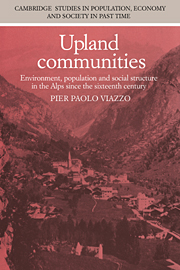 Upland Communities
Upland Communities Published online by Cambridge University Press: 13 October 2009
Closed systems, homeostasis and history
A major feature of the ecological model of the upland community presented in Chapter 1 is that the sequence of arguments which has been outlined parallels the main stages in the development of ecological anthropology, from Steward's ‘cultural ecology’ to Rappaport's ‘neo-functionalism’ and the more recent ‘processual’ approach. This does not mean of course, that the development of ecological anthropology has consisted in a smooth accumulation of information and insights. As Benjamin Orlove has rightly stressed, ‘each stage is a reaction to the previous one rather than merely an addition to it’. Nevertheless, each stage has been less a radical break from the previously dominant approach than an intellectual outgrowth of it. This explains why, instead of repudiating Steward's legacy, a number of anthropologists adopting an ecosystemic approach have tried to build upon the achievements of cultural ecology. In the field of Alpine studies, this is most clearly demonstrated by Netting's work, which mainly focusses on regulation but incorporates the Stewardian concerns with irrigation systems and intensification strategies. It also shares with the explicitly cultural-ecological models proposed by Burns and by later writers a set of assumptions and claims about the adaptivity of communal forms of social organization and the crucial structural importance of closed corporate communities in mountain areas. Admittedly, comparative work of the kind in which anthropologists like Rhoades and Thompson or Guillet have engaged inevitably presents considerable methodological problems.
To save this book to your Kindle, first ensure [email protected] is added to your Approved Personal Document E-mail List under your Personal Document Settings on the Manage Your Content and Devices page of your Amazon account. Then enter the ‘name’ part of your Kindle email address below. Find out more about saving to your Kindle.
Note you can select to save to either the @free.kindle.com or @kindle.com variations. ‘@free.kindle.com’ emails are free but can only be saved to your device when it is connected to wi-fi. ‘@kindle.com’ emails can be delivered even when you are not connected to wi-fi, but note that service fees apply.
Find out more about the Kindle Personal Document Service.
To save content items to your account, please confirm that you agree to abide by our usage policies. If this is the first time you use this feature, you will be asked to authorise Cambridge Core to connect with your account. Find out more about saving content to Dropbox.
To save content items to your account, please confirm that you agree to abide by our usage policies. If this is the first time you use this feature, you will be asked to authorise Cambridge Core to connect with your account. Find out more about saving content to Google Drive.